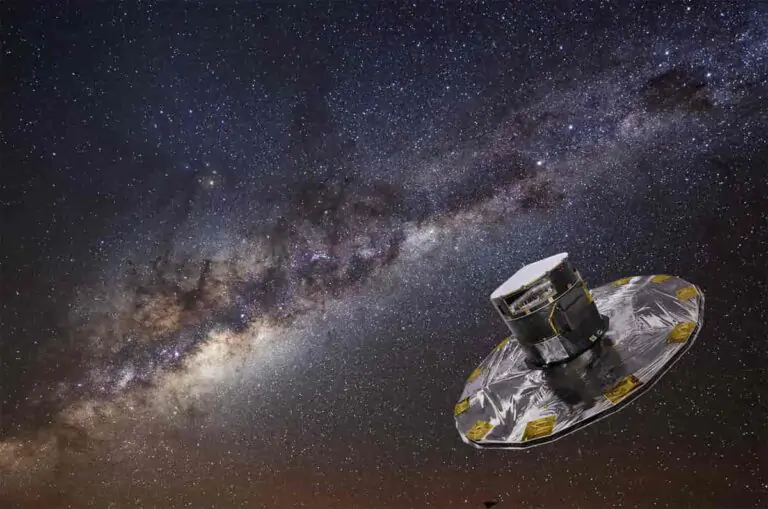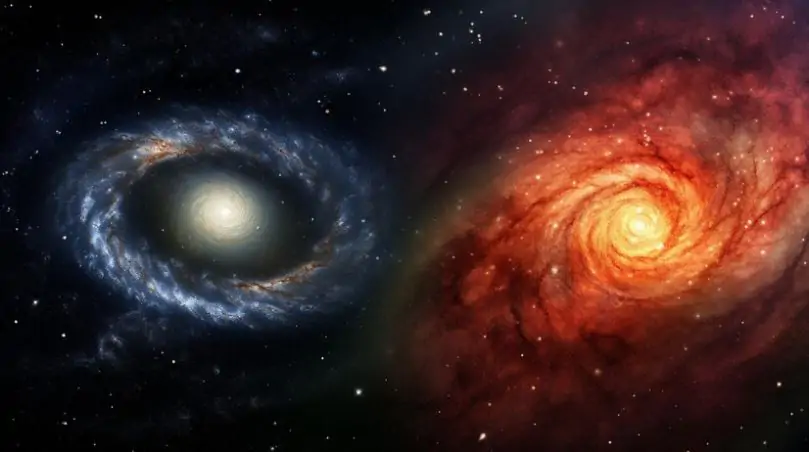Introduction
What may be the first two components of the Milky Way that have been discovered by astronomers? Known as “Shakti” and “Shiva,” they seem to be the remains of two galaxies that combined with an early Milky Way between 12 and 13 billion years ago, aiding in the early development of our own galaxy. The recent discovery is comparable to archaeologists discovering remnants of a prehistoric village that expanded into a sizable modern metropolis in terms of astronomy. It included merging measurements from the SDSS survey with data for about 6 million stars from ESA’s Gaia spacecraft. The Astrophysical Journal has published the findings.
The Milky Way, our home galaxy, was formed by the merger of smaller galaxies in its early history, which resulted in some very big construction components. Now, two of the oldest building blocks that may still be identified as such today have been identified by Khyati Malhan and Hans-Walter Rix of the Max Planck Institute for Astronomy: proto-galactic pieces that formed at the beginning of the universe’s galaxy formation phase, 12–13 billion years ago, when they merged with an early form of our Milky Way. The elements were detected by merging data from the SDSS survey with data from ESA’s astrometry satellite Gaia. The scientists have called these components Shakti and Shiva. The result is comparable to astronomers discovering evidence of a prehistoric village that expanded into a sizable modern metropolis.

Tracing the origins of stars that came from other galaxies
Many concurrent processes take place as galaxies collide and merge. Every galaxy has its own hydrogen gas reservoir. Those clouds of hydrogen gas are destabilised upon impact, and many new stars are produced inside. Naturally, the oncoming galaxies already have stars of their own, and during a merger, those stars will mix. These “accreted stars” will eventually make up a portion of the stellar population in the recently created merged galaxy. It may appear impossible to determine which stars originated in which parent galaxy when the merger is complete. But in reality, it is possible to trace back to stellar ancestry in at least some cases.
Fundamental concepts of physics can help. The majority of stars that remain after galaxies crash and mix together have very basic features that are closely related to the direction and speed of the galaxy from where they came. Astronomers refer to the momentum connected to rotation or orbital motion as angular momentum, and stars belonging to the same pre-merger galaxy have the same angular momentum values as well as energy values. Energy and angular momentum are preserved for stars travelling through a galaxy’s gravitational field; they don’t change over time. Search for sizable clusters of stars that have comparable, atypical angular momentum and energy values; the likelihood is that you will discover a merger remnant.
More hints can help with identification. More heavier elements, or “metals,” are found in stars that formed more recently than in stars that originated far earlier. The star most likely originated sooner, the lower the metal concentration, or “metallicity.”. Those who are attempting to find stars that were around 13 billion years ago should search for stars that have very little metal (“metal-poor”).
Virtual excavations in a large data set
It has only been feasible to recognise the stars that once belonged to a different galaxy and entered our Milky Way recently. Large, high-quality data sets are needed, and the analysis involves analysing the data in creative ways to find the class of items that are being searched for. It has only been a few years since this type of data collection became available. The best available data collection for this type of big-data galactic archaeology is the ESA astrometry satellite Gaia. Since its launch in 2013, it has generated progressively more precise data collection that, as of right now, contains the locations, position changes, and distances of about 1.5 billion stars in our galaxy.
The movements of stars in our own galaxy have been studied in a whole new way thanks to Gaia data, which has also revealed hitherto unidentified substructures. Among these is the so-called Gaia Enceladus/Sausage stream, which dates back between 8 and 11 billion years and is a relic of the most recent, bigger merger that occurred in our home galaxy. Two constructions found in 2022 are also included in it: the “poor old heart” of the Milky Way, discovered by Rix and colleagues, and the Pontus stream, discovered by Malhan and colleagues. The latter is a population of stars that are still found in the core area of our galaxy, having originated during the first mergers that produced the proto-Milky Way.
Traces of Shakti and Shiva
Malhan and Rix coupled Gaia data with precise star spectra from the Sloan Digital Sky Survey (DR17) for their current search. The latter offers comprehensive details on the chemical makeup of the stars. According to Malhan, “We noticed that, for a particular range of metal-poor stars, stars gathered around two particular kinds of energy and angular momentum.”
The two groupings of like-minded stars had relatively substantial angular momentum, corresponding with groups of stars that had been part of different galaxies that had merged with the Milky Way, in contrast to the “poor old heart,” which was also apparent in those plots. These two constructions are called Shakti and Shiva by Malhan; the latter is one of the main deities in Hinduism, while the former is a cosmic feminine power that is frequently shown as Shiva’s wife.
Together with their general low metallicity, which is comparable to that of the “poor old heart,” Shakti and Shiva provide a compelling case for being some of the Milky Way’s oldest relatives. According to Rix, “Shakti and Shiva might be the first two visitors to the ‘poor old heart’ of our Milky Way, starting its growth towards a large galaxy.”
A number of surveys that are either in progress or scheduled to begin in the coming years promise pertinent additional data. These include precise distances (LSST/Rubin Observatory) and spectra (SDSS-V, 4MOST), which should allow astronomers to definitively determine whether or not Shakti and Shiva represent a glimpse of the earliest prehistory of our home galaxy.

Conclusion
What may be the first two components of the Milky Way that have been discovered by astronomers? These are called ‘Shakti’ and ‘Shiva’, and they seem to be the remains of two galaxies that joined with an early Milky Way between 12 and 13 billion years ago, helping our own galaxy develop at first. The recent discovery is comparable to archaeologists discovering remnants of a prehistoric village that expanded into a sizable modern metropolis in terms of astronomy.
FAQ's
Q: What are Shakti and Shiva in the context of the Milky Way?
A: Shakti and Shiva are two ancient remnants discovered within the Milky Way, believed to be remnants of galaxies that merged with our own around 12–13 billion years ago. Named after Hindu deities, they represent some of the earliest building blocks of our galaxy.
Q: How were Shakti and Shiva identified?
A: In order to identify these ancient relics, astronomers analysed data from the Gaia satellite operated by ESA and the SDSS survey. Through the examination of stellar velocity, energy, and composition, scientists were able to determine the stars’ ancestry in the early phases of the Milky Way’s development.
Q: Why are Shakti and Shiva significant?
A: These relics reveal evidence about the merging processes that sculpted our galaxy billions of years ago, providing critical insight into the genesis of the Milky Way. Reassembling the early history of our cosmic home becomes easier when we comprehend these old components.
Q: How does this discovery compare to archaeological findings?
A: Unlike the discovery the ruins of an ancient town that eventually evolved into an advanced city, the discovery of Shakti and Shiva gives astronomers a window into the Milky Way’s early history. It’s comparable to using universal archaeology to discover the history of our cosmic lineage.
Q: What’s next in understanding the Milky Way’s history?
A: Upcoming and ongoing surveys like SDSS-V and LSST/Rubin Observatory will give additional details to help us understand Shiva, Shakti, and other ancient Milky Way features. These efforts promise to provide more information about the remote history of our galaxy.


Feel free to let me know if you need further assistance or if there’s anything else you’d like to add or modify!
“Hello there! I recently noticed that you’ve taken the time to visit my website, and I wanted to express my gratitude by returning the favor. As I’m constantly seeking ways to improve my site, I believe it would be beneficial to incorporate some of your ideas into my design and content strategy. Your input would be greatly appreciated, and I’m open to any suggestions you may have. Thank you for your interest, and I look forward to hearing from you!”
Feel free to let me know if you need further assistance or if there’s anything else you’d like to add or modify!
Feel free to let me know if you need further assistance or if there’s anything else you’d like to add or modify!
“Hello there! I recently noticed that you’ve taken the time to visit my website, and I wanted to express my heartfelt gratitude for your interest. Your support means a lot to me. In return, I would like to extend my support by visiting your website as well.
“Hello there! I recently noticed that you’ve taken the time to visit my website, and I wanted to express my heartfelt gratitude for your interest. Your support means a lot to me. In return, I would like to extend my support by visiting your website as well.
Certainly! Here’s an extended version of the message:
Thanks I have recently been looking for info about this subject for a while and yours is the greatest I have discovered so far However what in regards to the bottom line Are you certain in regards to the supply.
Wow amazing blog layout How long have you been blogging for you made blogging look easy The overall look of your web site is magnificent as well as the content.
Hello Neat post Theres an issue together with your site in internet explorer would check this IE still is the marketplace chief and a large element of other folks will leave out your magnificent writing due to this problem.